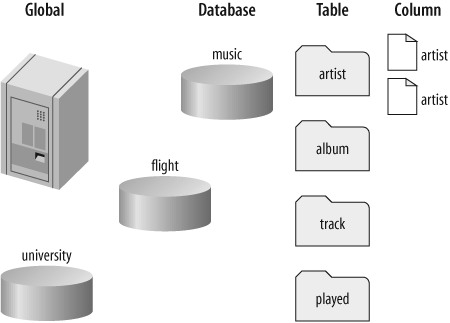How Privileges Interact
In the previous section, we explained how the GRANT OPTION privilege is used to pass
privileges to other users and how it allows privileges at lower levels
in the privilege hierarchy to be granted. In this section, we explore the privilege hierarchy
further and explain how MySQL allows or denies access to
resources.

Figure 9-1. The privilege hierarchy
Figure 9-1 shows an example of the
MySQL privilege hierarchy. There are four levels; reading from highest
to lowest, these are global, database, table, and column. In Figure 9-1, the global level contains the MySQL
server system and three databases: music, university, and flight. Each database contains tables; the
figure shows the tables in the music database. Each table in turn contains
columns, and the figure shows the columns in the artist table.
When you grant privileges at a level, those privileges are
available at that and all lower levels. In Figure 9-1, if you grant privileges at the global
level, those privileges are available for MySQL server functions and
throughout the databases, tables, and columns. For example, if you
have the UPDATE privilege at the
global level, you can execute the UPDATE statement on any table or column in any
database. If you grant privileges for only the music database, the privileges are available for just it and its tables and columns. Privileges never propagate up the hierarchy; ...
Get Learning MySQL now with the O’Reilly learning platform.
O’Reilly members experience books, live events, courses curated by job role, and more from O’Reilly and nearly 200 top publishers.

